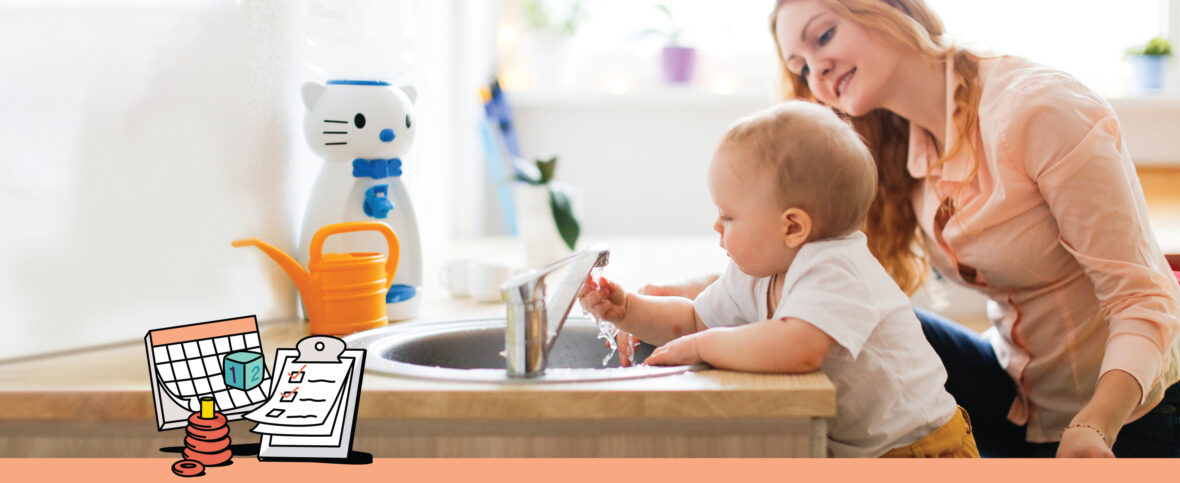See all > Parenthood

January 21, 2021 • read
Establishing a routine for babies & toddlers
Routine is essential for taking care of your little one. A structured schedule with a predictable order of operations is reassuring and can even lessen behavioural issues in children. So whether they’re three years old or two months, having a baby routine is key. It’s also a crucial part of sleep hygiene — and not just for babies. So if you’re wondering how, when and whether you should schedule your little one’s day, you’ve come to the right place.
Should I start my newborn on a schedule?
A baby routine is hard to come by in the first months. From about 1-3 months, your baby’s routine is just developing and they’ll likely sleep and eat at will instead of on a schedule. It’s not really worth looking up an example of a newborn routine because they’re not likely to keep to one until they’re a little older. Newborns can’t really stay awake for longer than 45 minutes to an hour and they frequently fall asleep nursing. Despite this, you can still begin to establish a bedtime routine at this age (more on this below). Over time, this routine will help to cue their body that it’s time to wind down for the day.
When to start a daily routine
Once they hit about four months, your baby (and let’s face it, you!) is usually ready to start sticking to a schedule a little more reliably. If you haven’t already, you’ll want to get a bedtime routine in place at this point. While it’s possible to implement a bedtime routine for a toddler, it’s much easier if you start well in advance so they’re used to it by the time they become a threenager. We suggest something like: bath, book, feed and bed. You’ll likely be nursing your little one to sleep for the first few months (if not longer). This is fine provided you’re not putting them down in their crib with a bottle (it’s bad for their teeth). Sleep training purists will likely tell you to push the feed earlier in the routine to get rid of any feed-to-sleep associations, but we’re all about what will get everyone the most sleep as smoothly as possible. If you do decide to sleep train, however, there’s nothing wrong with that either.
Once you get to the four-month mark, you can also begin to establish a daily routine. This won’t be a “hard and fast” schedule though until your baby moves to one nap somewhere between 13-18 months. This is because the timing of your daily routine will fluctuate slightly as you’ll likely be working with wake windows (the length of time your baby can stay up between naps). This is totally normal!
Bedtime routine for toddlers
Although the timing will vary, your child’s bedtime routine isn’t going to change that much as they age. Unless that is, you let your toddler decide the order of operations. Toddlers are masters at prolonging bedtime and if you leave it to them, things will get pretty crazy pretty fast. Unless you want the bedtime routine for your toddler to include an episode of Peppa Pig, multiple snacks, four trips to the potty, and 17 songs and stories, you’ll have to put your foot down.
Despite their wishes, your toddler’s bedtime routine should be short and sweet, clocking in at about half an hour (this is going to be aspirational at first but you’ll get there eventually). Start with a bath, followed by jammies, reading and bed. Somewhere in there you’ll brush their teeth and toilet them as well, just try to keep things in the same order to solidify the routine. And just like you, good sleep hygiene means no screens for at least an hour before bedtime. Pre-sleep time should be as soothing as possible, so as much as your toddler may want to play indoor basketball or practice their headstands, try and redirect them to a quieter activity.
Baby’s daily routine chart
Diaper changes aren’t included in this baby routine chart, but it’s expected that you’ll change your baby about every two hours (or when their diaper is wet or soiled) except during the overnight period. This schedule is appropriate for a baby between nine to 12 months who is on two naps, but can be adjusted up or down depending on whether your baby is older or younger. Check out our blog for more info on sleep needs by age.
- 6:00am Wake-up and nurse
- 7:30am Breakfast (solid foods)
- 8:30am Nap 1
- 10:00am Wake-up and nurse
- 11:30am Lunch (solids)
- 1:00pm Nap 2
- 2:30pm Wake-up and nurse
- 5:00pm Dinner (solids)
- 5:30pm Bath and books
- 6:00pm Nurse
- 6:30pm Bed
Each child is different, so if your baby’s schedule isn’t looking like your friends’ kids’ routine that’s ok! A few months in age can make a huge difference in sleep needs when your child is young, and they may need two naps long after their little friends have shifted to one. As long as your baby’s day is reasonably structured and both of you are getting enough sleep you’re doing great. And as always, if you have any questions, reach out to their pediatrician.
